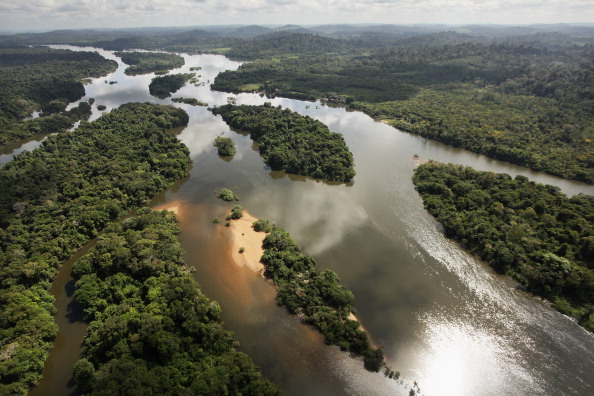
NEAR ALTAMIRA, BRAZIL - JUNE 15: The Xingu River flows near the area where the Belo Monte dam complex is under construction in the Amazon basin on June 15, 2012 near Altamira, Brazil. Belo Monte will be the world?s third-largest hydroelectric project and will displace up to 20,000 people while diverting the Xingu River and flooding as much as 230 square miles of rainforest. The controversial project is one of around 60 hydroelectric projects Brazil has planned in the Amazon to generate electricity for its rapidly expanding economy. While environmentalists and indigenous groups oppose the dam, many Brazilians support the project. The Brazilian Amazon, home to 60 percent of the world?s largest forest and 20 percent of the Earth?s oxygen, remains threatened by the rapid development of the country. The area is currently populated by over 20 million people and is challenged by deforestation, agriculture, mining, a governmental dam building spree, illegal land speculation including the occupation of forest reserves and indigenous land and other issues. Over 100 heads of state and tens of thousands of participants and protesters will descend on Rio de Janeiro, Brazil, later this month for the Rio+20 United Nations Conference on Sustainable Development or ?Earth Summit?. Host Brazil is caught up in its own dilemma between accelerated growth and environmental preservation. (Photo by Mario Tama/Getty Images)
[blogo-video id=”164544″ title=”Blitz di Greenpeace alla Siemens” content=”” provider=”askanews” image_url=”http://engine.mperience.net/cdn/static/img/tmnews/20160707_video_16004139.jpg” thumb_maxres=”0″ url=”20160707_video_16004139″ embed=”PGRpdiBpZD0nbXAtdmlkZW9fY29udGVudF9fMTY0NTQ0JyBjbGFzcz0nbXAtdmlkZW9fY29udGVudCc+PHNjcmlwdCB0eXBlPSJ0ZXh0L2phdmFzY3JpcHQiIHNyYz0iaHR0cDovL2VuZ2luZS5tcGVyaWVuY2UubmV0L0VuZ2luZVdpZGdldC9zY3JpcHRzL3dpZGdldF8xIj48L3NjcmlwdD48ZGl2IGNsYXNzPSJtcGVfd2lkZ2V0IiBkYXRhLW1wZT0ndHlwZT1wbGF5ZXJ8YXBwSWQ9MTl8dGFyZ2V0SWQ9MjAxNjA3MDdfdmlkZW9fMTYwMDQxMzl8cGxheWVyT3B0aW9ucz17ImF1dG9wbGF5Ijoibm9uZSIsImFkdlVSTCI6Imh0dHA6Ly9pYi5hZG54cy5jb20vcHR2P21lbWJlcj0zNzA3JTI2JWludl9jb2RlPXByZXJvbGwtYXNrYW5ld3MteDUwLWRlc2t0b3AiLCJ1c2VJbWFTREsiOnRydWV9Jz48L2Rpdj48c3R5bGU+I21wLXZpZGVvX2NvbnRlbnRfXzE2NDU0NHtwb3NpdGlvbjogcmVsYXRpdmU7cGFkZGluZy1ib3R0b206IDU2LjI1JTtoZWlnaHQ6IDAgIWltcG9ydGFudDtvdmVyZmxvdzogaGlkZGVuO3dpZHRoOiAxMDAlICFpbXBvcnRhbnQ7fSAjbXAtdmlkZW9fY29udGVudF9fMTY0NTQ0IC5icmlkLCAjbXAtdmlkZW9fY29udGVudF9fMTY0NTQ0IGlmcmFtZSB7cG9zaXRpb246IGFic29sdXRlICFpbXBvcnRhbnQ7dG9wOiAwICFpbXBvcnRhbnQ7IGxlZnQ6IDAgIWltcG9ydGFudDt3aWR0aDogMTAwJSAhaW1wb3J0YW50O2hlaWdodDogMTAwJSAhaW1wb3J0YW50O308L3N0eWxlPjwvZGl2Pg==”]
La formula di Greenpeace è sempre la stessa e funziona da decenni: occupare spazi pubblici con azioni spettacolari per amplificare i messaggi ecologisti. Non importa se il nodo della questione sia una realtà lontana migliaia di chilometri: l’importante è che l’azione dimostrativa sia potente e faccia parlare di sé.
In Italia l’ultimo blitz è andato in scena presso una sede di Siemens Italia dobe alcuni attivisti sono saliti sul tetto vestiti da animali e alberi della foresta, mentre altri suonavano strumenti a percussione.
L’obiettivo? Far ascoltare all’azienda e ai suoi dipendenti il battito del cuore della foresta amazzonica e chiedergli di non partecipare alla costruzione di una grande diga idroelettrica nel polmone verde del mondo.
In una lettera inviata a Siemens lo scorso maggio, Greenpeace aveva già chiesto all’azienda di dissociarsi pubblicamente, così come aveva fatto Enel, dal progetto di costruzione della diga di Sao Luiz do Tapaj s, nel cuore dell’Amazzonia brasiliana. Non avendo ricevuto risposte, è entrata in azione. Alcuni attivisti hanno anche mostrato le foto della devastazione causata dalla diga di Belo Monte, in costruzione nello Stato del Parà, dove ora si vorrebbe costruire la nuova: un progetto che ha avuto un devastante impatto sull’ambiente e sulle condizioni di vita dei popoli indigeni.
Martina Borghi, campagna foreste di Greenpeace Italia:
“Chiediamo a Siemens di dichiarare pubblicamente di essere contrari alla distruzione dell’Amazzonia e favorevole alla protezione dei diritti delle popolazioni indigene che vivono lì da generazioni e la cui sopravvivenza potrebbe essere messa a rischio dalla costruzione di mega progetti”.
Via | Askanews



